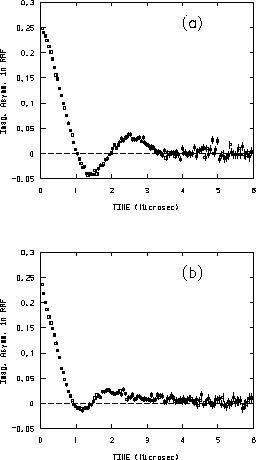In the vortex state the muons experience a spatially varying field strength
![]() .
Consequently the x-component of the
.
Consequently the x-component of the ![]() polarization may be written:
polarization may be written:
There
is no significant loss of polarization
during the short time over which the muons thermalize. This is because
the primary interactions by which the muons rapidly lose their initial
kinetic energy are electrostatic in nature and hence do not affect the
muon spin [80]. Loss of the muon spin polarization in the
vortex state is primarily due to the inhomogeneous
field distribution, which in turn can be related
to the magnetic penetration depth ![]() .
As
.
As ![]() decreases, the spatial variation in the magnetic field becomes greater and
there is a corresponding
increase in the relaxation rate of the
muon spin polarization (see Fig. 3.12).
As Fig. 3.1(b)
indicates, the field distribution for a perfect vortex lattice is far
from being gaussian, but rather is highly asymmetric.
decreases, the spatial variation in the magnetic field becomes greater and
there is a corresponding
increase in the relaxation rate of the
muon spin polarization (see Fig. 3.12).
As Fig. 3.1(b)
indicates, the field distribution for a perfect vortex lattice is far
from being gaussian, but rather is highly asymmetric.
 |
The interaction of the ![]() -spin with nuclear-dipolar fields
in the sample leads to further damping of the precession signal
and a corresponding broadening of the field distribution. Normally,
a gaussian distribution of the dipolar fields at the
-spin with nuclear-dipolar fields
in the sample leads to further damping of the precession signal
and a corresponding broadening of the field distribution. Normally,
a gaussian distribution of the dipolar fields at the ![]() -site
is assumed. Above Tc, this leads to a Gaussian relaxation function:
-site
is assumed. Above Tc, this leads to a Gaussian relaxation function:
For a real sample in the vortex state, decoration experiments have
shown that the vortex lattice is not perfect. Deviations from the
ideal flux-line lattice lead to a further relaxation of the
precession signal [72]. Consequently we can redefine the
relaxation function as:
It should be noted that the additional broadening of the field distribution due to flux-line lattice disorder is difficult to define. Because the field distribution corresponding to an ideal flux-line lattice is highly asymmetric, one would anticipate distortions of the lattice to also be asymmetric in nature. In Eq. (3.34) we are assuming the distortions are gaussian distributed, but it can be shown analytically that convoluting with a gaussian does not change the average field of the distribution.